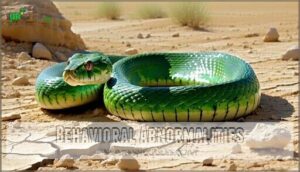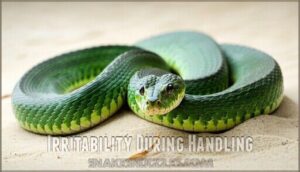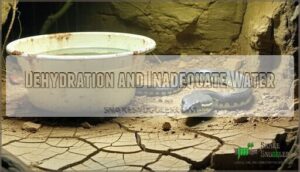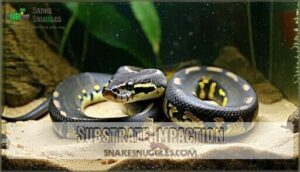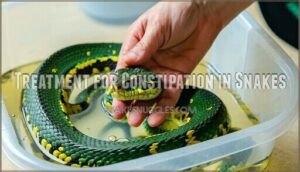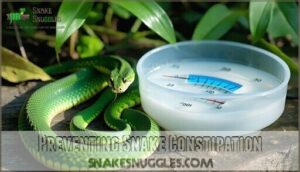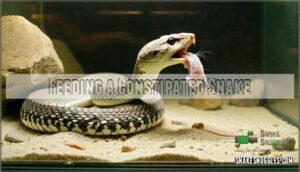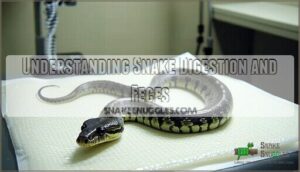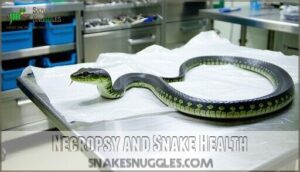This site is supported by our readers. We may earn a commission, at no cost to you, if you purchase through links.
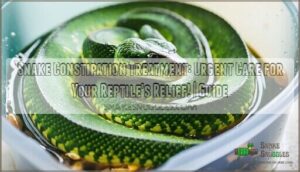
Gently massaging their belly, moving from head to tail, can help things along.
Check their habitat too—low temperatures, dry air, or improper substrate can cause issues.
Make sure they’re hydrated, as dehydration is a common culprit.
If nothing works, or if they seem bloated or in pain, call your vet right away.
Sometimes, impaction or underlying health problems need professional care.
A little attention now can save bigger problems later, so keep an eye on their behavior and eating.
Table Of Contents
- Key Takeaways
- Signs of Constipation in Snakes
- Causes of Snake Constipation
- Treatment for Constipation in Snakes
- Snake Impaction Diagnosis and Treatment
- Preventing Snake Constipation
- Feeding a Constipated Snake
- Recognizing Snake Impaction
- Managing Snake Constipation
- Understanding Snake Digestion and Feces
- Necropsy and Snake Health
- Frequently Asked Questions (FAQs)
- How do you treat a constipated snake?
- What can I do to relieve constipation?
- Why is my snake constipated?
- How do you get rid of a snake poop?
- How do you know if a snake is constipated?
- What happens if a snake doesn’t poop?
- How to help a snake with constipation?
- How can I tell if my snake is constipated?
- How to help a constipated reptile?
- How long can snakes go without pooping?
- Conclusion
Key Takeaways
- Start with warm water baths (85-90°F) for 15-20 minutes daily to relax your snake’s muscles and stimulate bowel movement, followed by gentle belly massage using circular motions from head to tail.
- Check your snake’s habitat—maintain proper temperature gradients (75-95°F), humidity levels (50-70%), and use safe substrates like cypress mulch to prevent impaction and support healthy digestion.
- Watch for warning signs like lack of bowel movement for over two weeks, unusual aggression, lethargy, loss of appetite, and a visibly swollen belly, as these indicate constipation that needs addressing.
- Don’t wait too long to seek veterinary care if home remedies aren’t working—professional intervention can prevent serious complications, as severe impaction may require diagnostic imaging or even surgery.
Signs of Constipation in Snakes
You’ll need to watch for key warning signs like lack of bowel movement for over two weeks, unusual aggression, sluggishness, loss of appetite, and a visibly swollen belly, as these indicate your snake may be constipated.
If you notice your reptile spending more time in warmer areas of its enclosure, straining during attempted defecation, or producing dry, hard feces, it’s time to take action for your pet’s comfort and health.
Lack of Bowel Movement
Monitoring your snake’s lack of bowel movement, often the first warning sign of constipation, requires careful attention to normal elimination patterns. Fecal absence exceeding two weeks typically indicates digestive stasis that needs addressing.
When tracking your snake’s gut motility, watch for these key indicators:
- Duration between meals and elimination (healthy snakes typically eliminate within 5-7 days after feeding)
- Changes in consistency or color of snake poop (dark, dry feces signal constipation)
- Complete absence of waste for longer than your snake’s normal elimination cycle
Remember that constipation duration varies by species, age, and size. A ball python might normally eliminate every 7-10 days, while larger species may go longer between bowel movements. Prolonged fecal absence often correlates with anorexia, as constipated snakes typically refuse food.
Behavioral Abnormalities
Constipated snakes often exhibit distinct behavioral abnormalities that serve as warning signs.
Constipated snakes may hide excessively, show unusual aggression, or display sudden restlessness—signals of digestive distress requiring prompt attention.
Your reptile might display increased hiding behavior or unusual aggression when approached.
Snake stress manifests through refusal handling, where previously docile pets suddenly hiss or strike when touched.
Weight loss may occur alongside these changes in snake behavior.
Watch for sudden shifts in temperament, excessive defensive posturing, or unusual restlessness in the snake enclosure.
These behavioral changes typically precede more severe symptoms of digestive distress.
They are critical signs that indicate your snake is experiencing stress.
Lethargy and Loss of Appetite
While behavioral changes signal trouble, lethargy and appetite loss are clear warning signs your snake’s digestive system is struggling.
Many owners mistake these symptoms for normal fasting, but they often indicate snake constipation.
Your typically active reptile may suddenly:
- Spend hours motionless in one spot, showing minimal energy conservation
- Refuse food even when offered favorite prey items
- Show reduced tongue flicking and environmental awareness
- Lose weight despite proper hydration importance
- Demonstrate unusual sleeping patterns unrelated to brumation
These symptoms can stem from underlying illness or environmental stressors. A key indicator is lethargy and anorexia.
Don’t wait for improvement – these signs require prompt snake vet advice to prevent serious digestive complications, as they can lead to severe health issues if not addressed promptly with proper digestive care.
Irritability During Handling
Your gentle snake’s sudden irritability is a key symptom of snake constipation. During handling, constipated snakes often display defensive behaviors due to physical discomfort.
| Pain Indicators | Temperament Changes | Owner Safety Actions |
|---|---|---|
| Hissing or striking | Previously docile snake becomes aggressive | Use gentle handling or avoid until recovery |
| Coiling tightly when touched | Refuses normal interaction | Minimize stress, provide space |
| Thrashing or rapid movement | Unusual defensive posture | Support body fully when necessary |
| Flinching at contact points | Consistent discomfort signs | Consult vet for handling advice |
Watch for these handling stress signals—they’re your snake’s way of communicating pain. If your normally calm reptile becomes defensive during handling, it’s time to pursue veterinary intervention. Remember, temperament changes often indicate underlying snake constipation causes that require prompt attention, including recognizing defensive behaviors and understanding the importance of gentle handling.
Physical Changes in The Abdomen
Your snake’s abdomen reveals important clues about potential constipation issues. When examining your reptile, watch for physical changes that might indicate digestive problems:
The abdomen holds vital clues—watch for swelling, discoloration, or firmness to detect early signs of potential digestive trouble in your reptile.
- Abdominal swelling or bloating, especially 1-2 inches above the vent area
- Discoloration of scales (typically bluish or reddish tints)
- A firm, palpable mass you can feel during gentle abdominal massage
- Fluid retention causing unusual softness or vent prolapse
These snake constipation symptoms shouldn’t be ignored. An impacted snake’s abdomen often appears visibly distended compared to its normal shape.
Regular observation helps you detect these physical changes early, potentially saving your pet from serious complications.
Causes of Snake Constipation
Your snake’s constipation can stem from various issues including dehydration, low temperatures in their enclosure, substrate ingestion, obesity from overfeeding, or parasitic infections.
Understanding these causes will help you identify and address the root problem before it develops into a more serious health concern for your reptile companion, which is crucial for maintaining their overall well-being and preventing further complications.
Dehydration and Inadequate Water
Dehydration can mess with your snake’s digestion, leading to tough, dry stools that cause snake constipation.
Without proper water provision, their hydration plummets, affecting overall health. Always offer fresh water and consider soaking options like shallow tubs to promote snake hydration.
Check humidity levels too—low moisture can worsen shedding issues and digestion. A quick turgor test (gently pinching the skin) can reveal dehydration.
Prioritize accessible water sources, and you’ll notice smoother shedding and a healthier, more comfortable snake. Ensuring your snake has constant access to water is essential for their health.
Low Temperature and Humidity
Cold, dry conditions can wreak havoc on your snake’s digestion.
Low temperatures and insufficient humidity often lead to metabolic slowdown, shedding issues, and dehydration risks.
To prevent constipation caused by poor environmental conditions, focus on these steps:
- Set enclosure temperatures: Keep a gradient between 75-85°F and a basking spot at 88-92°F.
- Boost humidity: Maintain 50-70% to avoid drying out.
- Use reliable heating tools: Avoid fluctuations.
- Monitor environmental conditions: Confirm consistent temperature regulation.
Substrate Impaction
Sometimes, what’s under your snake can cause more trouble than you’d think.
Substrate impaction happens when your snake accidentally swallows bedding particles like sand, gravel, or walnut shells.
These materials can clump in their digestive tract, leading to painful constipation and even life-threatening blockages.
Common impaction symptoms include a swollen belly, loss of appetite, and straining to defecate.
To avoid this, stick to safe substrate types like paper-based bedding or cypress mulch.
They’re less likely to be ingested and promote healthy digestion.
Regularly monitor your snake for any unusual behavior or physical changes.
If you suspect snake impaction, consult a vet immediately.
Early detection and preventative measures are key to keeping your pet healthy and comfortable.
Overfeeding and Obesity
Overfeeding might seem harmless, but it leads to obesity, which slows your snake’s metabolism and digestion.
This metabolic slowdown increases the risk of constipation.
To avoid these obesity risks, follow a proper snake feeding guide, match prey size to your snake’s widest body part and adjust feeding frequency based on age and activity.
Dietary management is key—monitor weight regularly and make certain meals aren’t too frequent or large, a balanced snake diet keeps digestion smooth.
Severe Parasitic Infections
Parasites can be sneaky troublemakers, leading to constipation in snakes by disrupting digestion.
Severe infections, like Cryptosporidium or hookworms, may cause bloating, weight loss, or straining. Keep a close watch on your snake’s stool and behavior—early detection is your best defense.
- Parasite Identification: Look for symptoms like vomiting or diarrhea.
- Infection Severity: Severe cases may require radiographs or necropsy.
- Treatment Options: Medications like metronidazole or fenbendazole help combat infections.
- Preventative Measures: Regular fecal exams and proper enclosure hygiene reduce risks.
Treatment for Constipation in Snakes
If your snake is constipated, there are a few effective steps you can take to help.
From warm water baths to adjusting their environment, these methods can provide relief and prevent further discomfort.
Warm Water Baths
A warm bath is a simple yet effective snake constipation treatment.
Use lukewarm water, keeping the Bath Temperature around 85-90°F.
Make certain the water is shallow enough for your snake’s comfort and safety.
Soak your snake for a Bath Duration of 10-15 minutes—this helps soften feces and stimulate movement.
For added benefits, consider Adding Electrolytes to the water.
You can find snake bath electrolytes online.
Always monitor your snake during warm water soaks and practice proper Post-Bath Care by drying them gently afterward.
Gentle Belly Massage
A gentle belly massage can be a game-changer for snake constipation treatment.
With care and patience, you can help your snake find relief.
Here’s how to perform an effective snake massage:
- Use circular motions with your fingertips, moving from head to tail.
- Apply light, steady pressure, especially near the lower belly.
- Massage for 5-10 minutes, ensuring your snake stays calm.
Pay attention to your snake’s comfort—if it shows signs of stress, stop immediately.
This massage technique, combined with proper hydration, can encourage bowel movement and improve your snake’s overall well-being.
Environmental Adjustments
Creating the right environment is key to effective snake constipation treatment.
Start by ensuring proper humidity levels (50-70%) and maintaining temperature gradients (75-85°F) to support digestion.
Use safe substrate choices like coconut husk to avoid impaction.
A larger enclosure size encourages movement, aiding bowel activity.
Moderate airflow prevents stagnation, while a consistent lighting schedule helps regulate their routine.
These environmental adjustments can make a world of difference, giving your snake the comfort it needs to stay regular.
Veterinary Consultation
When home remedies don’t work, it’s time for snake constipation veterinary intervention.
A reptile vet will assess your snake’s condition, often using diagnostic options like X-rays or ultrasounds to pinpoint the issue.
Treatments may include fluid therapy, enemas (with some risks), or even surgical necessity for severe cases.
Follow their post-op care instructions closely if surgery is needed.
Veterinary treatment guarantees your snake gets the best care, preventing complications.
Always prioritize herp vet expertise for your pet’s health—regular veterinary care can make all the difference in avoiding future digestive problems.
Don’t wait; act quickly to ensure your snake receives the necessary veterinary care.
Snake Impaction Diagnosis and Treatment
If your snake shows signs of impaction, like a swollen belly or straining, it’s vital to act quickly.
Diagnosis often involves radiographs, and severe cases may require surgery to remove blockages, which can be a severe situation.
Radiography for Diagnosis
When your snake’s constipation lingers, radiographs are a key diagnostic tool.
These x-rays provide a clear view of internal blockages, like fecaliths, helping veterinarians pinpoint the issue.
Image interpretation guarantees precise treatment, reducing guesswork.
Sometimes, contrast agents are used to highlight problem areas, making impaction diagnosis even clearer.
Radiation safety is always a priority, so procedures are quick and controlled.
If your snake requires anesthesia for stillness, vets carefully weigh anesthesia risks.
For milder cases, alternative imaging methods may suffice.
Diagnostic tests like these are essential for accurate snake constipation diagnosis and effective veterinary care.
Surgery for Impaction Removal
When all else fails, surgery becomes the lifeline for severe snake impaction.
A vet performs a precise incision to remove the blockage, guaranteeing your snake’s organs stay unharmed. While surgical risks exist, the benefits often outweigh them.
Here’s what happens:
- Incision and Removal: Blockage is carefully extracted.
- Anesthesia Protocols: Keeps your snake still and safe.
- Post-op Care: Guarantees smooth recovery.
Anesthesia and Post-Operative Care
During surgery, anesthesia risks are carefully managed by monitoring your snake’s breathing and heart rate.
Postoperative care is all about creating a recovery environment that feels safe and familiar. Keep humidity and temperature steady, and check the incision daily for redness or swelling.
Pain management, including prescribed medications, guarantees comfort. Feeding post-op may take time, so patience is key while your snake heals.
Maintaining proper humidity is key to preventing future impactions.
Importance of Early Detection
Catching reptile constipation signs early can save your snake from unnecessary pain and serious complications.
Look for impacted snake symptoms like a lack of appetite, unusual lethargy, or a subtle belly bulge.
Early intervention and preventative measures minimize severity, improve prognosis, and reduce complications.
Don’t ignore constipation symptoms—recognizing impaction quickly makes treatment easier and more effective, which could mean the difference between simple care and invasive surgery for your pet, emphasizing the importance of acting fast to ensure the best prognosis.
Preventing Snake Constipation
Keeping your snake healthy starts with preventing constipation through proper care.
By maintaining the right temperature, providing fresh water, and avoiding overfeeding, you can guarantee their digestive system stays on track, which is crucial for preventing constipation.
Providing a Temperature Gradient
A proper temperature gradient is vital for your snake’s digestion and overall well-being.
Snakes rely on thermoregulation to process food efficiently, so setting up their enclosure right is key.
Use a heat source, like a lamp, to create a basking spot around 90°F (32°C) on one side and a cooler zone on the other.
Here’s how to maintain it:
- Install a thermostat to regulate basking temperatures.
- Place a thermometer in both zones for gradient monitoring.
- Make certain consistent enclosure temperatures for comfort.
- Watch your snake move between zones—it’s their natural digestive rhythm!
Offering Fresh Water and Proper Substrate
Keeping your snake hydrated is key to avoiding constipation. Always provide fresh water in a bowl large enough for soaking, but shallow enough to prevent drowning.
Place the water source in an accessible, shaded spot within the enclosure. Daily water changes guarantee cleanliness and proper snake hydration.
Choose a safe substrate like cypress mulch or aspen shavings. Avoid fine substrate particle sizes, such as sand or gravel, which can cause impaction if ingested.
Substrate should retain moisture without becoming soggy. Humidity maintenance matters too—aim for 50-70% by misting the enclosure.
A clean, well-maintained habitat with fresh water and safe substrate types promotes healthy digestion and helps prevent snake constipation effectively. Consider browsing different options for a quality snake bowl.
Avoiding Overfeeding and Obesity
Portion control plays a big role in keeping your snake healthy and active.
Overfeeding can lead to obesity, which slows digestion and raises constipation risks.
Stick to these feeding tips:
- Follow feeding schedules based on your snake’s age and species.
- Offer prey size that matches your snake’s widest body part—no larger.
- Monitor weight regularly to guarantee a healthy balance.
A proper diet prevents obesity and keeps your snake’s digestion running smoothly.
Regular Observation and Veterinary Care
Spotting issues early is half the battle regarding snake health.
Regular checkups and health monitoring are key preventative measures.
Watch for lethargy, appetite changes, or bloating.
Feel for unusual lumps during handling, and keep your snake’s enclosure clean with proper temperatures and humidity.
Always have a plan for snake veterinary care—know your vet and prepare for emergencies.
Proactive husbandry and expert intervention guarantee your snake stays healthy.
Early detection saves lives, so don’t skip those vet visits!
Regular checkups are crucial for maintaining your snake’s overall health.
Feeding a Constipated Snake
Feeding a constipated snake requires careful attention to guarantee their digestive system gets back on track.
Stick to smaller, appropriately sized prey and make sure the environment feels safe and stress-free for feeding attempts.
Scent-Enhancing Techniques
When your snake isn’t eating, boosting prey scent might help.
Warming prey slightly with a blow dryer enhances scent and makes it more appealing. For natural scents, try rubbing prey with fish oil or soaking it in chicken broth.
Braining, or cutting into the prey’s skull, releases stronger odors for stubborn feeders. Scent application, like dragging prey across the snake’s enclosure, can trigger hunting instincts.
Appetite stimulation may take time, so be patient and consistent. For an added boost, consider a snake constipation diet supplement to support digestion, giving your pet every chance at relief and satisfaction.
Providing a Quiet and Secure Environment
Creating a healing environment is key for stress reduction.
Dim the lights, minimize noise, and make certain your snake has hiding places for comfort.
Use a secure enclosure or separate feeding space to prevent substrate ingestion.
Your handling practices should be gentle, avoiding sudden moves that might startle.
A quiet environment helps your snake feel safe and relaxed, making it more likely to eat and recover naturally.
Consulting a Veterinarian for Advice
When constipation refuses to budge, it’s time to seek expert consultation.
A reptile veterinarian can evaluate your snake and recommend effective treatment suited to its situation. Veterinary care guarantees safe diagnostic options and enhances treatment efficacy.
Here’s how a veterinary consultation can help:
- Diagnostic options include X-rays or ultrasounds to identify blockages.
- Treatment efficacy improves with prescribed medications or enemas.
- Preventative strategies focus on proper hydration, diet, and habitat changes.
- Long-term care plans address recurring issues and overall health.
- Emergency care saves your snake in severe cases like impaction.
Don’t hesitate—a professional’s touch can offer timely relief!
Recognizing Snake Impaction
If your snake hasn’t eaten or had a bowel movement in weeks, it might be dealing with impaction, a serious form of constipation.
Watch for signs like a swollen belly or straining and consult a vet promptly to confirm the issue with radiography.
Lack of Appetite and Bowel Movement
When your snake skips meals and ignores nature’s call, it could signal distress.
Appetite loss and no bowel movement are major red flags for impaction. Watch for bloating or lethargy; these may indicate blocked digestion.
Immediate actions like warm baths or gentle belly massages can help. Proper hydration impacts gut motility, so make certain to provide fresh water daily.
If the issue persists, consider snake constipation treatment options to avoid severe issues like anorexia or impaction.
| Symptom | What It Means | Action |
|---|---|---|
| Skipping meals | Possible gut blockage | Warm bath, hydrate |
| No poop for weeks | Constipation or impaction | Massage, observe behavior |
| Bloated appearance | Digestive trouble | Seek veterinary advice |
| Lethargy | Discomfort or pain | Environmental adjustments |
Radiography for Confirmation
Diagnosis is the key to solving your snake’s constipation puzzle, and radiographs offer a clear view of what’s happening internally.
Think of them as a window into your reptile’s digestive tract, revealing blockages like fecaliths—hard, compact masses causing trouble.
Here’s why radiographs are vital:
- Radiograph Interpretation pinpoints blockages like large white circular shapes.
- Contrast Studies may be needed for a deeper look at severe impactions.
- Veterinarians guarantee accuracy while minimizing anesthesia risks.
- Alternative Imaging, like ultrasounds, may complement radiographs for tricky cases.
- Discuss cost considerations upfront, as imaging and treatment can vary in price.
Prompt radiography aids in identifying a blockage’s location and severity, guaranteeing the right treatment plan.
While waiting, keep your snake calm and hydrated.
Veterinary care can mean the difference between relief and a worsening impaction.
Managing Snake Constipation
When your snake is constipated, it’s essential to act quickly to address the issue and keep your pet comfortable.
By monitoring its behavior, adjusting the environment, and consulting a vet if needed, you can help restore its digestive health.
Monitoring and Recording Behavior
Pay close attention to your snake’s behavioral baselines, appetite tracking, activity logs, and shedding patterns.
Keep a simple journal to record feeding times, snake bathroom habits, and how often snake poop is spotted. If bowel movements slow or odd behaviors emerge, write it down.
Spotting changes early, like a skipped meal or restless hiding, helps get ahead of issues. Tracking your scaly buddy’s quirks isn’t just helpful—it strengthens the unique bond you share.
Recognizing behavioral abnormalities such as hiding or sluggishness can be an early indicator of constipation.
Adjusting Environment and Diet
Your snake’s comfort starts with the right environment.
Keep a temperature gradient of 75-95°F and maintain humidity at 60-70% for smoother digestion.
Use safe substrates like cypress mulch to prevent impaction.
Adjust their diet by offering prey the size of their widest body part every 10-14 days.
Always provide fresh water for soaking and drinking.
Seeking Veterinary Care When Necessary
Sometimes, your snake needs professional help to avoid further risks. If constipation persists, reach out to a qualified snake vet for emergency signs.
Professionals offer safe diagnostic options and treatments, including anesthesia or surgery if required.
- Book preventative checkups to monitor health.
- Contact a vet immediately for appetite loss or severe lethargy.
- Follow post-treatment care instructions to aid recovery.
Understanding Snake Digestion and Feces
Snakes have unique digestive systems, relying on slow metabolism and infrequent feeding to conserve energy.
Understanding how they process food and produce waste helps you identify signs of constipation and guarantee your pet stays healthy.
Snake Digestive System and Energy Conservation
Snakes have an impressive digestive system that works like a light switch, turning on when needed and off when not.
Between meals, their organs shrink, conserving energy—a survival trick tied to their low metabolic rate. When digestion begins, their body ramps up, demanding oxygen to process food efficiently.
This energy-saving method, known as the adaptive ballast hypothesis, guarantees longer survival during fasting but highlights the need for proper care to avoid issues. Their digestive system is so efficient, they produce potent acids to dissolve bones and meat.
| Aspect | Description |
|---|---|
| Metabolism | Slows between meals, conserving energy |
| Organ Activity | Shrinks when fasting, expands post-meal |
| Thermoregulation | Critical for digestion efficiency |
| Energy Storage | Allows survival during long fasts |
| Feeding Frequency | Tied to snake species and size |
Infrequent Feeders and Lower Metabolic Rates
A snake’s digestion is like a slow cooker—it thrives on patience. Their metabolic slowdown means digestion frequency is low, especially during brumation effects.
With metabolic rates designed for efficiency, snakes may eat only monthly, which isn’t a concern.
Keep these in mind:
- Digestion requires proper hydration.
- Low temperature slows prey digestion.
- Long gaps between meals are normal.
- Reduced activity aids efficient energy use.
- Less frequent bowel movements are expected.
Adaptive Ballast and Hunting Advantage
Every part of snake digestion serves a purpose, even constipation.
Your snake’s ability to hold feces isn’t random—it’s Ballast Adaptation, adding precision to its movements.
Consider this evolutionary advantage:
- Ground-dwellers: Hold waste for weight and muscular control, striking prey harder.
- Arboreal snakes: Stay light, releasing waste often to move swiftly.
- Digestive timing: Lets them balance energy, stability, and prey capture.
This hunting advantage showcases nature’s clever strategy behind snake digestion.
Necropsy and Snake Health
A necropsy helps you understand what went wrong with your snake’s health by examining its internal organs closely.
It can reveal important information about underlying issues, guiding future care and advancing veterinary knowledge, specifically by shedding light on underlying health problems.
Detailed Examination of Internal Organs
A necropsy gives you critical insights into your snake’s internal health. It’s like solving a mystery, piece by piece.
Each system—digestive tract, urogenital, respiratory, and cardiovascular—is examined in detail. Signs of issues like bowel obstruction or fecal stones are documented.
This thorough check of organ morphology identifies problems in digestion and the digestive system, helping vets refine care strategies, ensuring healthier reptiles in the future.
Respiratory infections, for example, can be identified during necropsy, especially with signs of pneumonia.
Determining Cause of Death and Impact on Health
A necropsy gives you incredible insight into your snake’s health story, identifying issues like organ pathology or digestion-related complications that may have gone unnoticed.
Necropsy findings, such as signs of disease, toxin analysis results, or evidence of disease transmission, connect symptoms to a deeper cause.
This isn’t just about closure; it’s about learning preventative measures for future pets.
Whether surgery or anesthesia impacted recovery, understanding these implications sharpens your knowledge to support better snake health outcomes.
Informing Future Research and Veterinary Practice
A necropsy isn’t just closure; it’s a gateway to progress in snake care.
By sharing your snake’s story, you’re fueling future research that shapes diagnostic advances, novel therapies, and preventative strategies.
Vets study necropsy insights to uncover nutritional impacts or genetic predispositions, improving veterinary practice and outcomes.
Each finding sharpens care protocols, ensuring better health for others.
Your decision aids science and also offers hope for countless snakes needing improved veterinary improvements through well-informed strategies.
Frequently Asked Questions (FAQs)
How do you treat a constipated snake?
Start by giving your snake a warm water bath and gently massaging its belly in circles.
Fix enclosure conditions—temperature, humidity, and substrate.
If symptoms persist or worsen, consult a vet for proper treatment and care.
What can I do to relieve constipation?
Nearly 40% of reptile owners face constipation issues with their pets.
Give your snake a warm bath for 15-20 minutes, gently massage its belly, and make certain proper temperature and humidity in its enclosure.
Why is my snake constipated?
Your snake’s constipation could be caused by dehydration, low enclosure temperatures, substrate ingestion, overfeeding, or parasitic infections. Check your husbandry practices, especially temperature gradient, humidity levels, and appropriate substrate choices.
How do you get rid of a snake poop?
Like tackling a stubborn mess, remove snake waste by wearing gloves, scooping up the poop with disposable tools, placing it in a sealed bag, and disinfecting the area afterward.
Wash your hands thoroughly.
How do you know if a snake is constipated?
You’ll notice your snake hasn’t defecated for over two weeks, has a visibly swollen belly.
It shows unusual aggression or lethargy, loses interest in food.
It possibly spends more time in warmer areas of its enclosure, which can be a sign of unusual behavior.
What happens if a snake doesn’t poop?
If your snake doesn’t poop for over two weeks, it can develop impaction, causing bloating, lethargy, and appetite loss.
Without treatment, toxins build up, potentially leading to serious health complications or death.
How to help a snake with constipation?
Approximately 60% of captive snake constipation cases resolve with simple home treatments.
Give warm water baths (85°F) for 15-20 minutes, gently massage their belly, increase enclosure temperatures, and make certain proper hydration and humidity.
How can I tell if my snake is constipated?
You’ll notice your snake is constipated if it hasn’t defecated in over two weeks, shows a swollen belly, becomes lethargic, refuses food, or strains when attempting to pass waste.
How to help a constipated reptile?
While you might worry it’s serious, you can help your constipated reptile with warm water soaks (15-20 minutes), gentle belly massage, increased enclosure humidity, and proper hydration.
Consult a vet if symptoms persist.
How long can snakes go without pooping?
Healthy snakes can go 1-2 weeks without pooping, but some species may go 2-3 months during brumation. If your snake hasn’t pooped in over 2 weeks during active periods, it’s concerning.
Conclusion
Preventive practices protect your pet’s prolonged health.
By implementing the snake constipation treatment techniques outlined above, you’ll help your serpent stay comfortable and healthy.
Remember to monitor their environment, feeding schedule, and behavior closely.
Don’t delay seeking veterinary care if home remedies aren’t working—professional intervention can prevent life-threatening impaction.
With proper attention to hydration, habitat, and handling, you’ll guarantee your scaly companion enjoys superior digestive health for years to come.
- https://www.quora.com/I-feed-my-snake-about-2-weeks-ago-and-she-hasn-t-pooped-yet-this-isn-t-normal-for-her-What-should-I-do
- https://www.vetlexicon.com/exotis/reptiles/gastrohepatology/articles/constipation/
- https://veterinarypartner.vin.com/doc/?id=7996830&pid=19239
- https://lbah.com/reptile/snake-impaction/
- https://www.youtube.com/watch?v=UwFqtt3idBc


